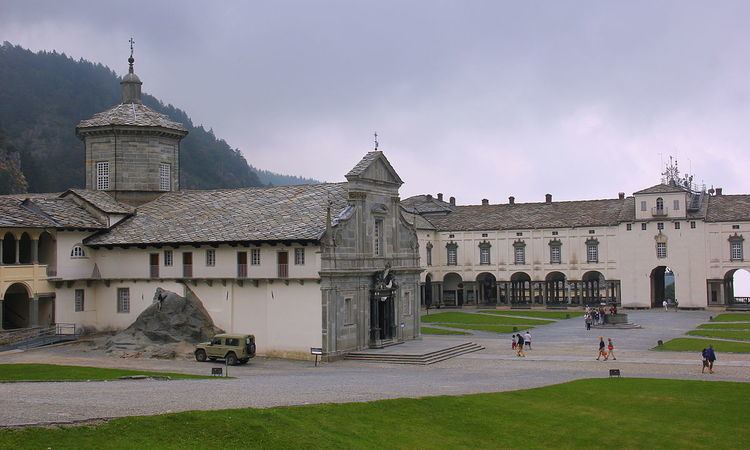Location Biella Denomination Catholic Architectural type Mainly baroque Province Province of Biella Dedication Black Virgin of Oropa | Country Italy Authorising papal bull Opened 1960 Phone +39 015 2555 1200 | |
 | ||
Website www.santuariodioropa.it/db/it/ Address Riserva Naturale Speciale del Sacro Monte di Oropa, Via Santuario D'Oropa, 480, 13900 Oropa, Biella BI, Italy Diocese Roman Catholic Diocese of Biella Similar Monte Mucrone, Lago del Mucrone, Sacro Monte di Oropa, Sacri Monti of Piedmont, Parco Burcina Natural R Profiles | ||
Walking tour of the sanctuary of oropa
The Sanctuary of Oropa (Italian: santuario di Oropa), is a group of Roman Catholic buildings and structures in the municipality of Biella, Italy. It is located at a height of 1,159 metres in a small valley of the Alpi Biellesi.
Contents
- Walking tour of the sanctuary of oropa
- Sanctuary of oropa brief history
- HistoryEdit
- Devotion and popular beliefsEdit
- PilgrimagesEdit
- Nature conservationEdit
- CiclingEdit
- Other projectsEdit
- References
Sanctuary of oropa brief history
HistoryEdit
According to legend, a black wooden statue of the Virgin Mary carved by Saint Luke was found in Jerusalem by Saint Eusebius of Vercelli and carried to Oropa in the 4th century AD and placed into a small niche in a big boulder. Around that niche housing the statue in the Middle Ages was built first a church, which during the early 17th century was replaced with what is known today as the Ancient Basilica. In the following two centuries several other buildings were added to the complex, including the royal apartments of the House of Savoy, a big library and the Royal Gate, a masterpiece designed by the architect Filippo Juvarra in the 18th century.
The last building added to the sanctuary was the Upper Basilica, a monumental church built between 1885 and 1960 due the large number of pilgrims visiting Oropa. Its dome is 80 metres high and the church can hold 3000 people.
In 1617, the construction of the Sacro Monte di Oropa (literally Sacred Mount of Oropa) was built not far from the sanctuary. It is a devotional path now composed of twelve chapels (plus another seven nearby) containing groups of statues representing scenes from the story of the Virgin Mary's life.
Near the Sacro Monte in the XIX century was built a new graveyard, where the noble families of the Biellese territory built their family tombs. Some graves have free masons symbols, such as Quintino Sella's one.
Devotion and popular beliefsEdit
The statue of the black Madonna has always been venerated and to the Virgin of Oropa are attributed miracles and protections. The town of Biella made a vow during the XVII century plague and it wasn't infected. Following this grace, the town does a pilgrimage every year to the sanctuary in order to thank the Virgin Mary.
People during the centuries made ex-voto (for grace) pictures to thank the Virgin Mary. All of these pictures are still preserved in the sanctuary in the 'ex voto gallery'. The oldest picture dates back to 1522 and was made by painter Bernardino Lanino.
The popular belief says that the wooden statue has some peculiar characteristics:
PilgrimagesEdit
Around 800,000 pilgrims and one-hundred pilgrimages visit the sanctuary each year.
The evocative and ancient pilgrimage from Fontainemore to Oropa takes place every five years.
Nature conservationEdit
The mountain area surrounding the sanctuary is included in a regional park of 1,518.28 ha (code: EUAP0882) named Riserva Naturale Speciale del Sacro Monte di Oropa.
CiclingEdit
The Sanctuary has been five times the end of a stage of the Giro d'Italia.
Other projectsEdit
Media related to Sacro Monte (Oropa) at Wikimedia Commons
